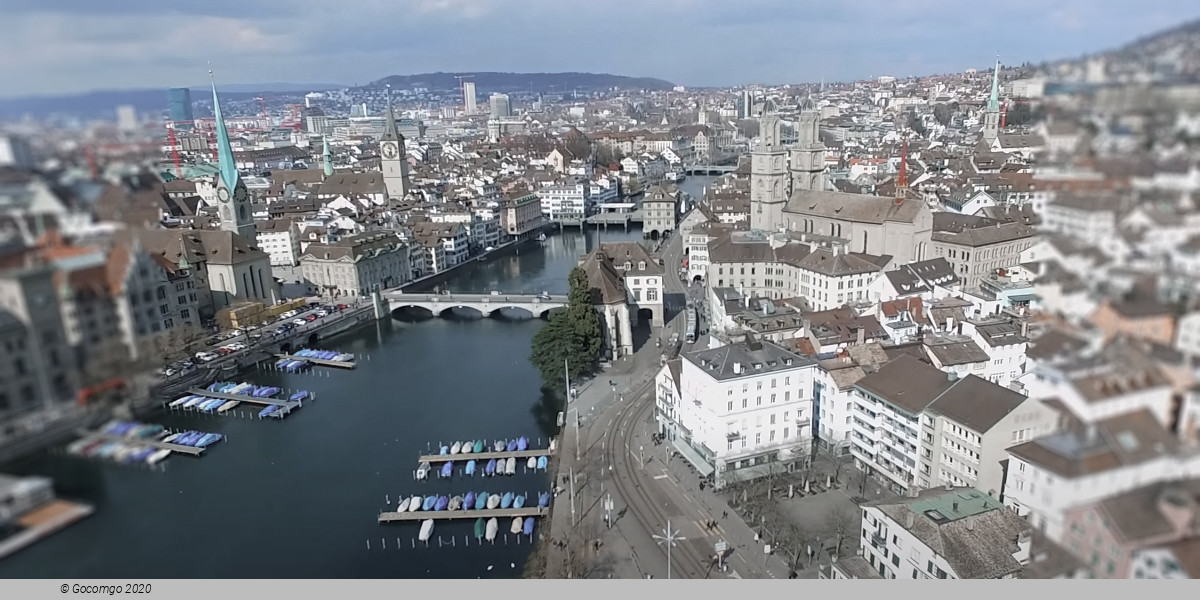Zurich

Zürich is the largest city in Switzerland and the capital of the canton of Zürich. It is located in north-central Switzerland, at the northwestern tip of Lake Zürich. Many museums and art galleries can be found in the city, including the Swiss National Museum and Kunsthaus. Schauspielhaus Zürich is considered to be one of the most important theatres in the German-speaking world. Zürich has a rich cultural tradition. In addition to high-quality museums and galleries, Zürich has high-calibre chamber and symphony orchestras and several important theatres.
The Zürich Opera House (German: Zürcher Opernhaus), built in 1834, was the first permanent theatre in the heart of Zürich and was at the time, the main seat of Richard Wagner's activities. Later in 1890, the theatre was re-built as an ornate building with a neo-classical architecture. The portico is made of white and grey stone ornamented with the busts of Wagner, Weber and Mozart. Later, busts of Schiller, Shakespeare and Goethe were also added. The auditorium is designed in the rococo style. Once a year, it hosts the Zürcher Opernball with the President of the Swiss Confederation and the economic and cultural élite of Switzerland. The Ballet Zürich performs at the opera house. The Zürich Opera Ball, a major social event, is held annually at the Opera House as a fundraiser for the opera and ballet companies.
The Schauspielhaus Zürich is the main theatre complex of the city. It has two dépendances: Pfauen in the Central City District and Schiffbauhalle, an old industrial hall, in Zürich West. The Schauspielhaus was home to emigrants such as Bertolt Brecht or Thomas Mann, and saw premieres of works of Max Frisch, Friedrich Dürrenmatt, Botho Strauss or Elfriede Jelinek. The Schauspielhaus is one of the most prominent and important theatres in Switzerland.
The Theater am Neumarkt is one of the oldest theatres of the city. Established by the old guilds in the Old City District, it is located in a baroque palace near Niederdorf Street. It has two stages staging mostly avantgarde works by European directors.
The Zürcher Theater Spektakel is an international theatre festival, featuring contemporary performing arts.
The Zurich Film Festival is an international film festival, lasting 11 days and featuring popular international productions.
One of the largest and most popular annual events in Zürich is the Street Parade, which is also one of the largest techno and dance music festivals in the world. Proceeding along the side of Lake Zürich, it is normally held on the second Saturday in August. The first edition was held in 1992 with about 1,000 participants. By 2001 the event attracted one million participants. The Zürifäscht, on the other hand, is a triennial public festival. It features music, fireworks set to music, and other attractions throughout the old town. It is the largest public festival in Switzerland and attracts up to 2 million visitors.
The Kunst Zürich is an international contemporary art fair with an annual guest city; it combines most recent arts with the works of well-established artists. Another annual public art exhibit is the city campaign, sponsored by the City Vereinigung (the local equivalent of a chamber of commerce) with the cooperation of the city government. It consists of decorated sculptures distributed over the city centre, in public places. Past themes have included lions (1986), cows (1998), benches (2003), teddy bears (2005), and huge flower pots (2009). From this originated the concept of the CowParade that has been featured in other major world cities.
Zürich has been the home to several art movements. The Dada movement was founded in 1916 at the Cabaret Voltaire. Artists like Max Bill, Marcel Breuer, Camille Graeser or Richard Paul Lohse had their ateliers in Zürich, which became even more important after the takeover of power by the Nazi regime in Germany and World War II.
The best known traditional holiday in Zürich is the Sechseläuten (Sächsilüüte), including a parade of the guilds and the burning of "winter" in effigy at the Sechseläutenplatz. During this festival the popular march known as the Sechseläutenmarsch is played. It has no known composer but likely originated in Russia. Another is the Knabenschiessen target shooting competition for teenagers (originally boys, open to female participants since 1991).
Most of Zürich's sites are located within the area on either side of the Limmat, between the Main railway station and Lake Zürich. The churches and houses of the old town are clustered here, as are the most expensive shops along the famous Bahnhofstrasse. The Lindenhof in the old town is the historical site of the Roman castle, and the later Carolingian Imperial Palace.
Compared to other cities, there are few tall buildings in Zürich. There are numerous examples of brutalist buildings throughout the city, including the Swissmill Tower which, at 118m, is the world's tallest grain silo.
The prehistoric settlements at Enge Alpenquai and Grosser Hafner and Kleiner Hafner are part of the Prehistoric Pile dwellings around the Alps a UNESCO World Heritage Site.

